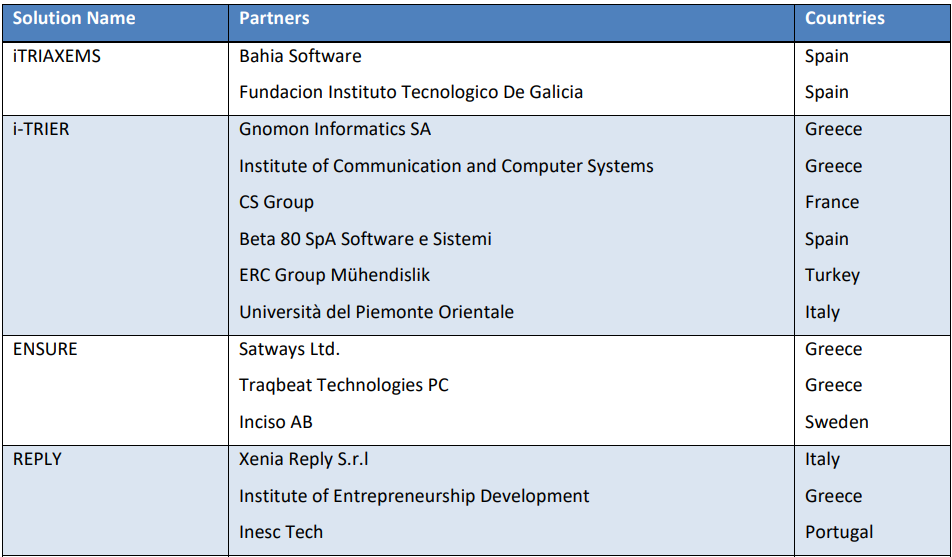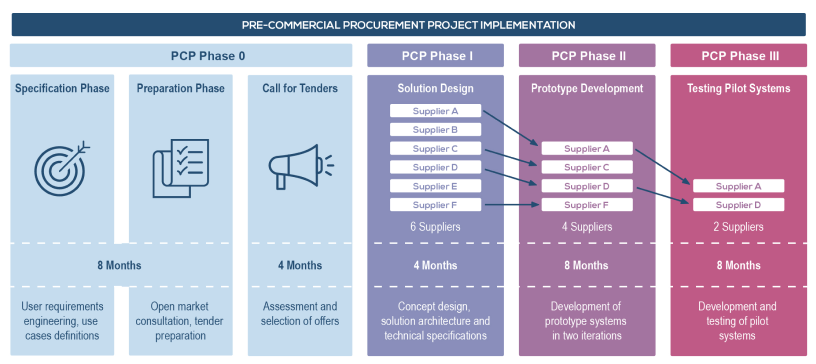 https://www.synyo.com/wp-content/uploads/SYNYO-NEWS-featured-image-NEW01007705EN.png
400
459
leo
https://www.synyo.com/wp-content/uploads/2017/09/synyo-logo.png
leo2025-01-01 10:47:112025-02-10 10:48:51BOND: Outcomes in Advancing Education, Tolerance and Heritage Preservation to combat Antisemitism
https://www.synyo.com/wp-content/uploads/SYNYO-NEWS-featured-image-NEW01007705EN.png
400
459
leo
https://www.synyo.com/wp-content/uploads/2017/09/synyo-logo.png
leo2025-01-01 10:47:112025-02-10 10:48:51BOND: Outcomes in Advancing Education, Tolerance and Heritage Preservation to combat Antisemitism
iProcureSecurity PCP: Implementation of Phase II – Prototype Development
Following the successful completion of Phase I -Solution Design, during which the R&D providers developed the overall architecture of their solutions, the iProcureSecurity PCP project is now progressing into Phase II – Prototype Development. Out of the seven contractors involved in the preceding phase, four have been selected to advance and test prototypes of their solutions across the five Public Buyers’ countries – Spain, Italy, Greece, Turkey, and Austria. The implementation of Phase II started in February 2023 and will end in September 2023.
In Phase I, seven contractors were involved in designing the conceptual architecture and the technical specifications for their solutions. This process was guided by the requirements from the public procurers, as well as use cases and service process models. After a thorough evaluation, four of these contractors have been awarded to advance to Phase II – Prototype Development. The selected four contractors comprise national and international consortia, consisting of a total of 14 organisations spanning seven countries.

About the Phase II
Phase II runs from February 2023 to September 2023. During this phase, contractors will embark on two distinct iterations of prototype development and testing. Each iteration will be conducted separately for the public procurers in all five countries. The first iteration (v1) is dedicated to developing non- or partly functional prototypes of key systems components. All five v1 demonstrations will be conducted virtually in March 2023. The test outcomes of this iteration will be collected and analysed to inform the further development of the second iteration (v2). The v2 demonstrations are scheduled to take place in July 2023 and in person across all five procurer countries – Spain, Italy, Greece, Turkey, and Austria. The outcomes of v2 prototype testing will also play a pivotal role in the evaluation of the overall phase outcomes.
The image below shows the overall structure of the different project phases, as well as the competitive process for the contractors.

About the four awarded bids
Below are the abstracts of the solutions, that will develop prototypes of their concepts in Phase II:
iTRIAXEMS: The iTRIAXEMS solution aims to address the challenges faced by European Emergency Medical Services in mass casualty events when it comes to improving triage practices, resource allocation, decision-making, availability, security, and data protection in a crisis management context. In response to this challenge, we propose the development of a cloud platform which combines software and hardware components that will allow to go a step beyond the current state of the art, due to the application of innovative technologies and functionalities, such as Triage Tag Devices, Drones, Artificial Vision, or AI technologies. The execution of the project will be based on agile methodologies, co-design strategies, and the active involvement of qualified experts. We expect the development of iTRIAXEMS to have a major impact on victims and procurers, and to reduce the number of fatalities and serious sequelae when a mass-casualty incident is declared.
Watch supplier insights from iTRIAXEMS here.
i-TRIER: I-TRIER brings as a legacy one of the very first fully digitized Triage Solutions, widely adopted Crisis Management System and Computer Aided Dispatch systems and a unique toolkit of Hospital Management Systems providing interoperability solutions for unifying Emergency and Victim Tracking data domains with the health-data related ones. i-TRIER brings also to the forefront the citizens through the management of their PHR and by securely providing access to it by EMS. A modular, open, interoperable yet strongly integrated solution will be provided, through advancements in existing functionalities both in hardware and software components. i-TRIER will establish a flexible interoperability framework through an efficient streaming mechanism and local exchange of information. Towards the design and testing of the i-TRIER solution, the technology providers will be supported by experts throughout its development stages, ensuring that KPIs related to the MCI response will be improved.
Watch supplier insights from i-TRIER here.
ENSURE: ENSURE system aims at strengthening the response of Emergency Medical Services (EMS) and Responders (EMR) to Mass Casualty Incidents (MCIs). The latter are called to operate under stressful and uncertain environments, given that MCIs are usually evolved in complex and confusing situations. In the first phase of the project, the consortium is designing a novel digital triage system by utilizing the unique expertise of Satways, Traqbeat and Incisio. By leveraging hands on experts’ experience in emergency medicine (Incisio), the project will combine medical wearables (Traqbeat) with emergency management system (Satways) into a novel digital triage system for MCIs. In a disaster event, the system will enable the quick prioritization of those who need high medical attention by automatically recognizing and continuously monitoring their vital signs via an attachable patch from the disaster location to the hospital.
Watch supplier insights from ENSURE here.
Reply: Reply for Innovative SCenario in Emergency Development – Design and build an MCI management solution, integrated with external EHR systems to speed up and outperform the continuous handover process of data collection and sharing required from the beginning of the triage process until the hospitalization of the casualties. In order to support the different actors in this process the platform will include the digitalization of procedures and algorithms already in use in MCI management enhanced by a decision support system and by the exploitation of AI/ML modules. The solution will include a “Digital Triage Tag” composed of a smartphone and wearable devices to enable the collection of vital parameters in real-time to build the profile of the casualties and inform their state of severity along the process. The solution is built to support different types of roles and stakeholders of the system and it’s designed to ensure a high level of configurability for each profile. The architecture proposed aims to build a resilient, performing, safe and interoperable platform and will be deployable in a hybrid, cloud-based or on-premises environments, so that it can be easily replicable across different geographic regions.
Watch supplier insights from Reply here.
Next Steps
The Phase II, which ends in September 2023, will be followed by the Phase III, with two bids continuing their R&D efforts. Phase III is dedicated to the Development and Testing of Pilot Systems. In this crucial phase the real-world application and testing of these pilot systems will take place, actively involving patients, EMTs, and medical professionals across Spain, Italy, Turkey, Greece, and Austria. The public procurers in these countries will choose specific testing scenarios and host three significant events, namely Equipment Set-Up, Solution Introduction, On-Site Training, and Pilot Operation.
More information on the next phases will be available in the next articles.
Stay updated, and subscribe to the iProcureSecurity PCP Newsletter.
Links
Keywords
Pre-Commercial Procurement, PCP, Triage Management Systems, Emergency Medical Services, Solution Design, Prototype Development, Pilot Operations, Call for tenders Results, Innovation Needs, Innovation Procurement, Disaster Management, Technology, Innovation





